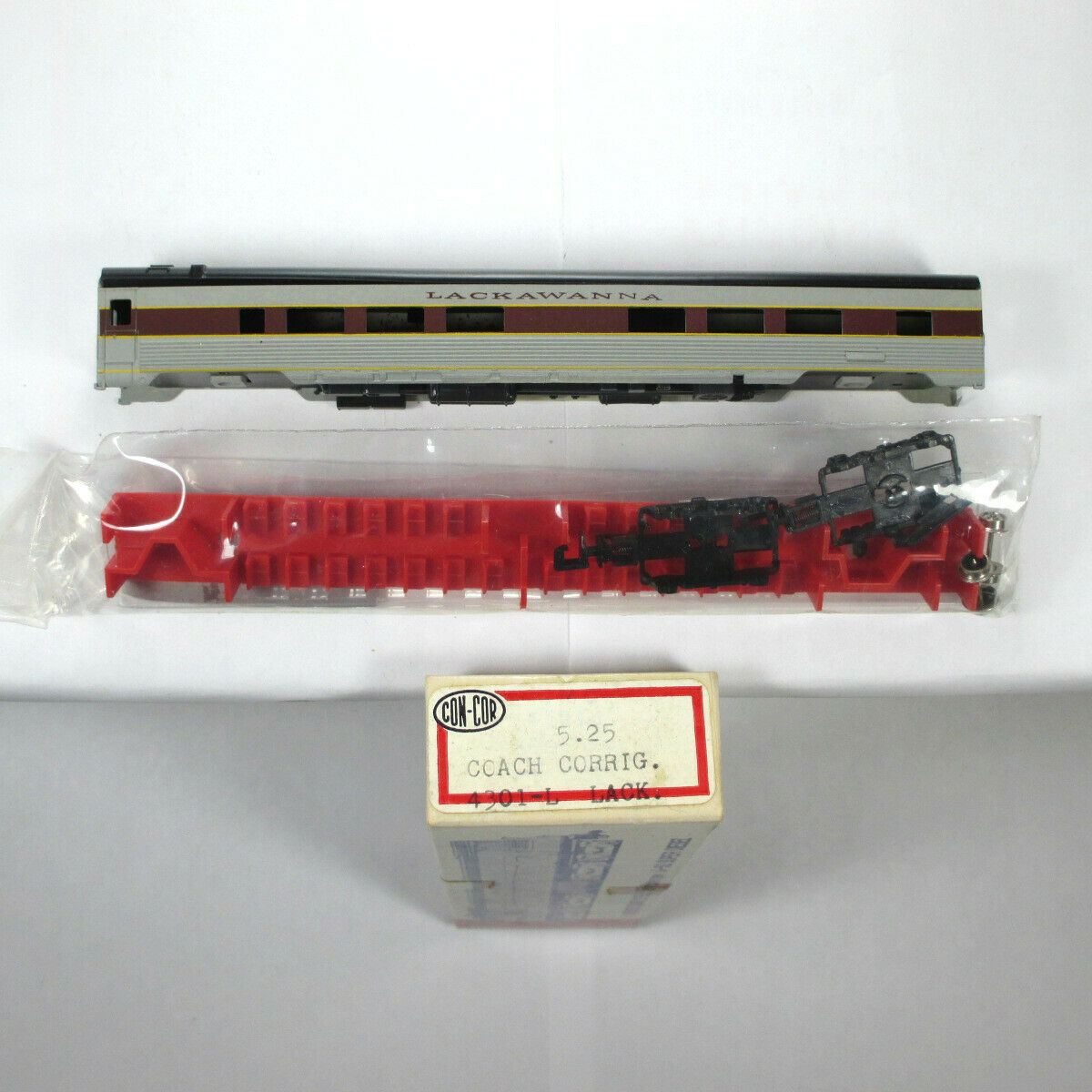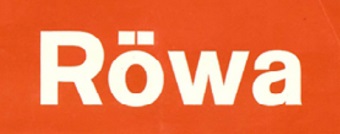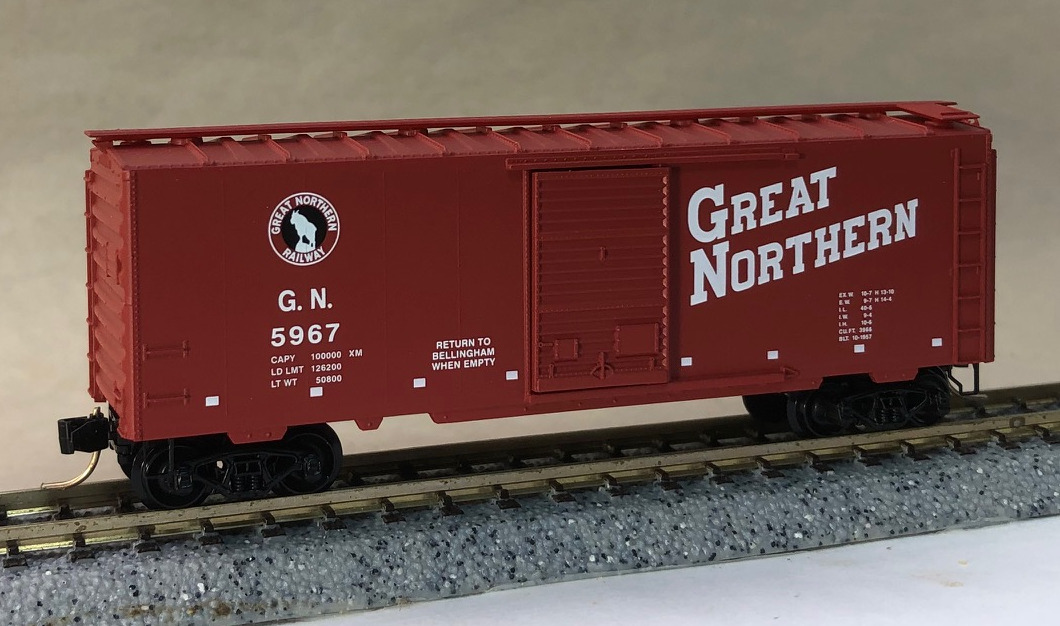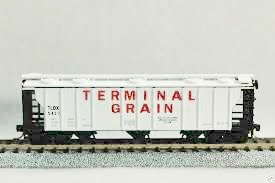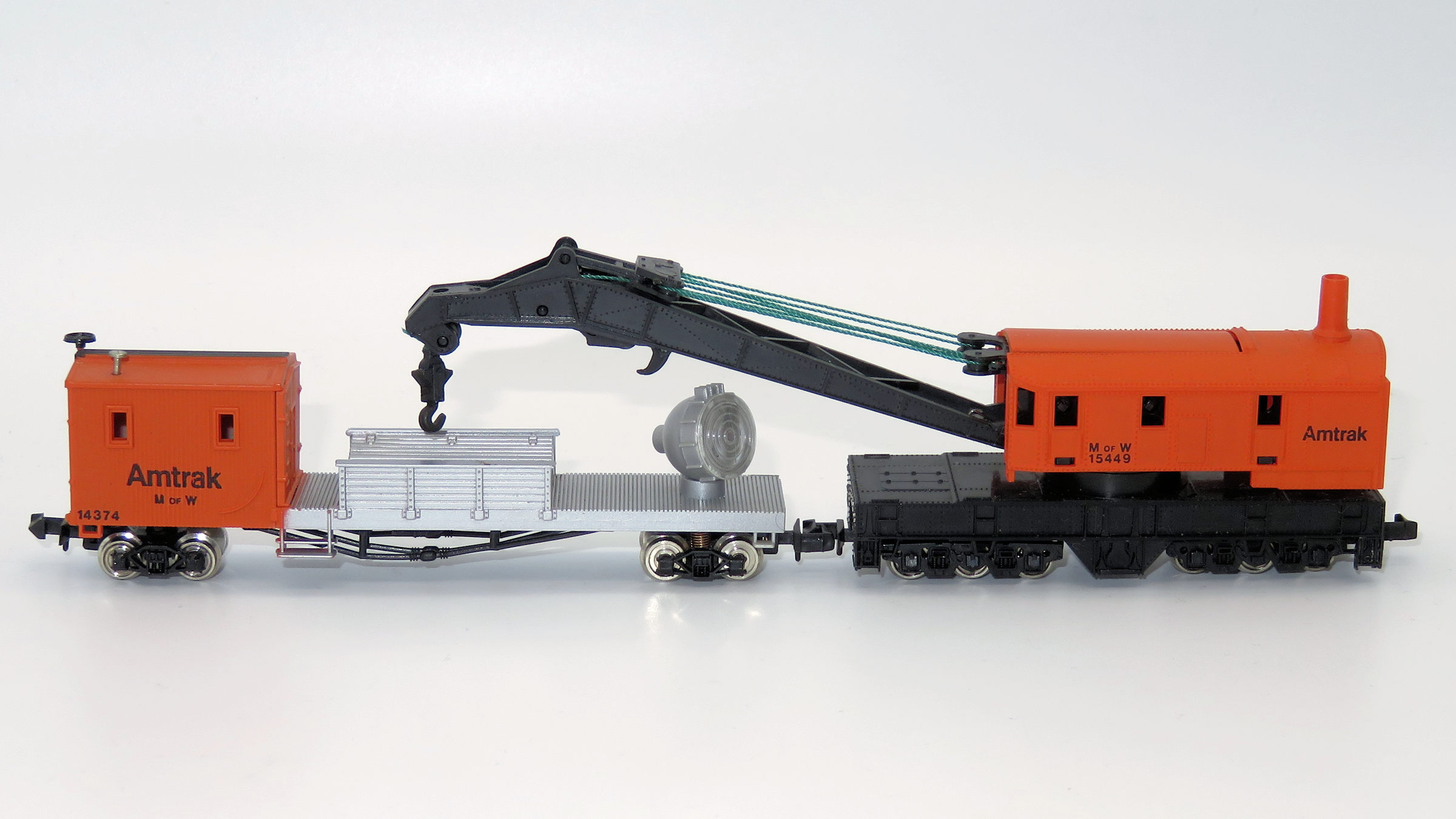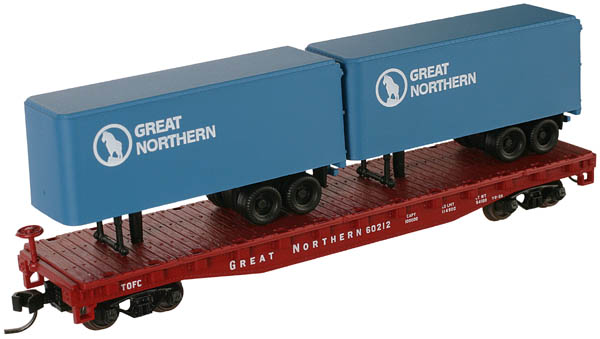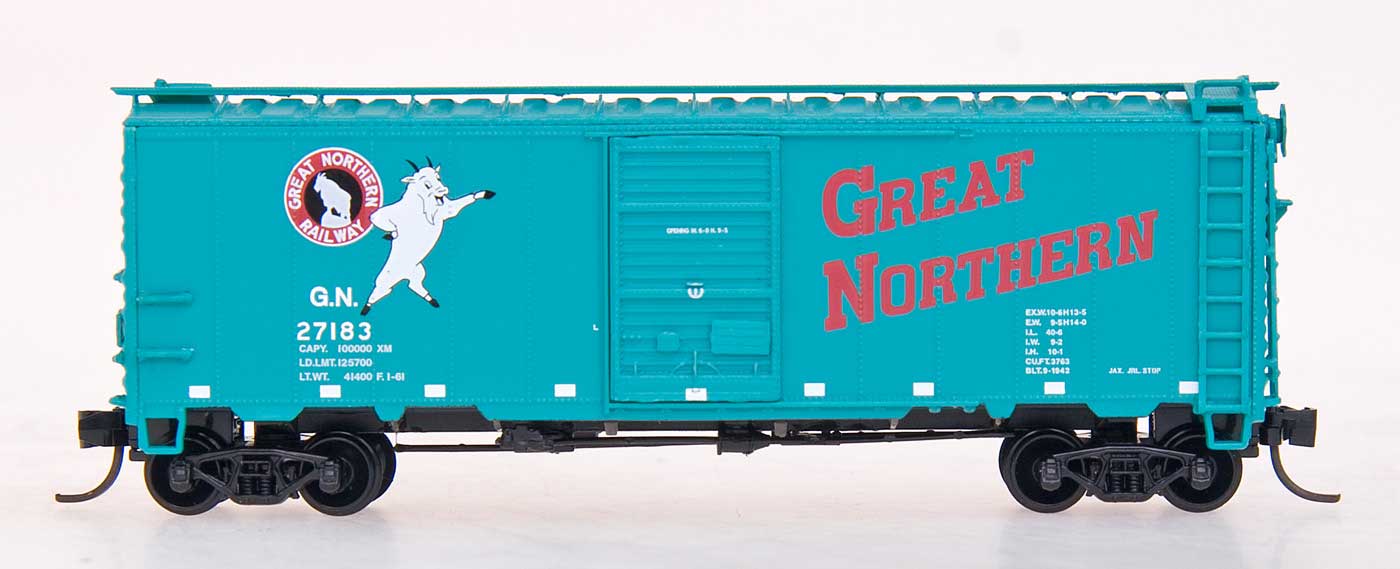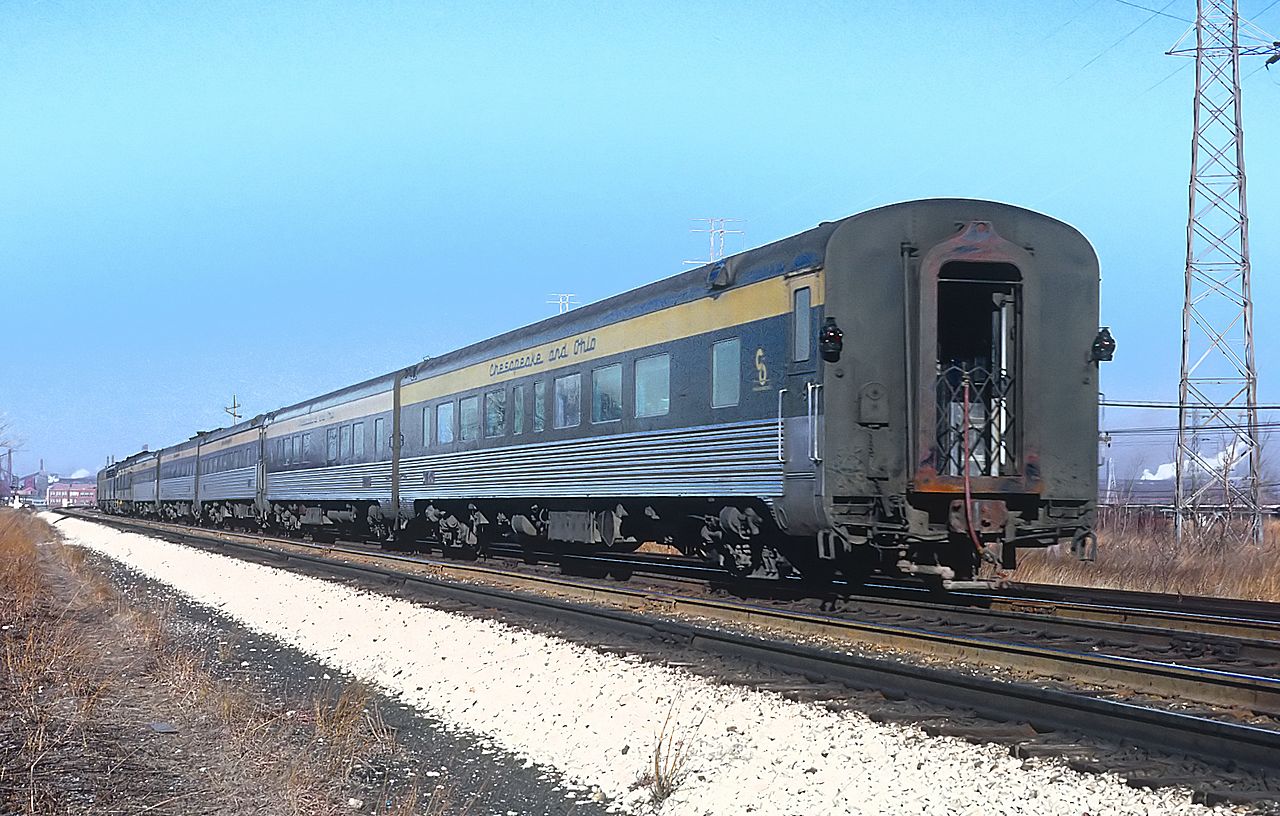Model Information: These cars were originally manufactured for MRC by Röwa (Germany) in the end 1960s-early 1970s. Röwa also sold them under its own brand. Post-MRC, Con-Cor distributed them for a while under its brand name and attempted to acquire the tooling in order to set up production of these cars at Rivarossi. However, said tooling was eventually lost (or confiscated) and these models subsequently vanished from the face of the earth. They have metal window frames, close-coupling, diaphragms and venetian blinds in the windows. Some come equipped with interior lighting.
This model was made after the Pullman 85' coach built for the C&O in 1950.
This model was made after the Pullman 85' coach built for the C&O in 1950.
Prototype History: The Pullman built cars ordered by Chesapeake & Ohio (C&O) after WWII were semi-corrugated, i.e. corrugated on the lower half, but smooth on the upper half and roof.
Some of these cars ended up on a few other railroads because C&O backed away from their plans for expanding their service putting the excess cars on the market. D&RGW took some of the sleepers and some of the blunt end observation cars ended up on the B&O. Two of the coaches wound up on the SP. But C&O had some or of all of them so that would be the road to decorate them in. Note that the Pere Marquette, Nickel Plate, and other road's semi-corrugated cars look like the C&O cars but actually have more corrugations under the windows and so are not an exact match.
Coach: The car is in two sections divided in the center. Fifty-nine coaches in the 1610-1668 series were delivered to the C&O by Pullman in 1950 for service on most C&O trains, including the George Washington. Eight of these cars were sold to the D&RGW. C&O removed the corrugations in 1967.
Sleeper: This is the Pullman 85' 10-roomette/6-bedroom sleeper built for the C&O in 1950 in the “City of…” series, and 56 were made. Some C&O cars were used on the Pere Marquette. Cars were also sold to ACL, B&O, D&RGW and IC. The Nickel Plate also bought 13 of these 10/6 cars new in 1950 from PS, also named “City of…”.
Observation: This is the Pullman 85’ 5 double bedroom, buffet, 26-seat lounge, blunt end observation car (floor plan 4165) built for the C&O in 1950. Eight cars were built in the “Club” series and used on several trains by the C&O. Some of the C&O cars were modified for mid-train operation. Some were later sold to the B&O, who used them on the Capitol Limited.
Some of these cars ended up on a few other railroads because C&O backed away from their plans for expanding their service putting the excess cars on the market. D&RGW took some of the sleepers and some of the blunt end observation cars ended up on the B&O. Two of the coaches wound up on the SP. But C&O had some or of all of them so that would be the road to decorate them in. Note that the Pere Marquette, Nickel Plate, and other road's semi-corrugated cars look like the C&O cars but actually have more corrugations under the windows and so are not an exact match.
Coach: The car is in two sections divided in the center. Fifty-nine coaches in the 1610-1668 series were delivered to the C&O by Pullman in 1950 for service on most C&O trains, including the George Washington. Eight of these cars were sold to the D&RGW. C&O removed the corrugations in 1967.
Sleeper: This is the Pullman 85' 10-roomette/6-bedroom sleeper built for the C&O in 1950 in the “City of…” series, and 56 were made. Some C&O cars were used on the Pere Marquette. Cars were also sold to ACL, B&O, D&RGW and IC. The Nickel Plate also bought 13 of these 10/6 cars new in 1950 from PS, also named “City of…”.
Observation: This is the Pullman 85’ 5 double bedroom, buffet, 26-seat lounge, blunt end observation car (floor plan 4165) built for the C&O in 1950. Eight cars were built in the “Club” series and used on several trains by the C&O. Some of the C&O cars were modified for mid-train operation. Some were later sold to the B&O, who used them on the Capitol Limited.
Road Name History: 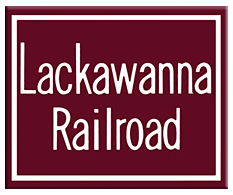 The Delaware, Lackawanna & Western Railroad Company (DL&W or Lackawanna Railroad) was a U.S. Class 1 railroad that connected Buffalo, New York, and Hoboken, New Jersey, a distance of about 400 miles (640 km). Incorporated in 1853, the DL&W was profitable during the first two decades of the twentieth century, but its margins were gradually hurt by declining traffic in coal and competition from trucks. In 1960, the DL&W merged with rival Erie Railroad to form the Erie Lackawanna Railroad.
The Delaware, Lackawanna & Western Railroad Company (DL&W or Lackawanna Railroad) was a U.S. Class 1 railroad that connected Buffalo, New York, and Hoboken, New Jersey, a distance of about 400 miles (640 km). Incorporated in 1853, the DL&W was profitable during the first two decades of the twentieth century, but its margins were gradually hurt by declining traffic in coal and competition from trucks. In 1960, the DL&W merged with rival Erie Railroad to form the Erie Lackawanna Railroad.
The Liggett's Gap Railroad was incorporated on April 7, 1832, but stayed dormant for many years. It was chartered on March 14, 1849, and organized January 2, 1850. On April 14, 1851, its name was changed to the Lackawanna and Western Railroad. The line, running north from Scranton, Pennsylvania, to Great Bend, just south of the New York state line, opened on December 20, 1851. From Great Bend the L&W obtained trackage rights north and west over the New York and Erie Rail Road to Owego, New York, where it leased the Cayuga and Susquehanna Railroad to Ithaca on Cayuga Lake (on April 21, 1855). The C&S was a re-organized and partially re-built Ithaca and Owego Railroad, which had opened on April 1, 1834, and was the oldest part of the DL&W system. The whole system was built to 6 ft (1,829 mm) broad gauge, the same as the New York and Erie, although the original I&O was built to standard gauge and converted to wide gauge when re-built as the C&S.
The Delaware and Cobb's Gap Railroad was chartered December 4, 1850, to build a line from Scranton east to the Delaware River. Before it opened, the Delaware and Cobb's Gap and Lackawanna and Western were consolidated by the Lackawanna Steel Company into one company, the Delaware, Lackawanna and Western Railroad, on March 11, 1853. On the New Jersey side of the Delaware River, the Warren Railroad was chartered February 12, 1851, to continue from the bridge over the river southeast to Hampton on the Central Railroad of New Jersey. That section got its name from Warren County, the county through which it would primarily run.
In the wake of Hurricane Diane in 1955, all signs pointed to continued financial decline and eventual bankruptcy for the DL&W. Among other factors, property taxes in New Jersey were a tremendous financial drain on the Lackawanna and other railroads that ran through the state, a situation that would not be remedied for another two decades.
To save his company, Lackawanna president, Perry Shoemaker, sought and won a merger agreement with the Erie Railroad, the DL&W's longtime rival (and closest geographical competitor). The merger was formally consummated on October 17, 1960. Shoemaker drew much criticism for it, and would even second-guess himself after he had retired from railroading. He later claimed to have had a "gentlemen's agreement" with the E-L board of directors to take over as president of the new railroad. After he was pushed aside in favor of Erie managers, however, he left in disillusionment and became the president of the Central Railroad of New Jersey in 1962.
Read more on Wikipedia.

The Liggett's Gap Railroad was incorporated on April 7, 1832, but stayed dormant for many years. It was chartered on March 14, 1849, and organized January 2, 1850. On April 14, 1851, its name was changed to the Lackawanna and Western Railroad. The line, running north from Scranton, Pennsylvania, to Great Bend, just south of the New York state line, opened on December 20, 1851. From Great Bend the L&W obtained trackage rights north and west over the New York and Erie Rail Road to Owego, New York, where it leased the Cayuga and Susquehanna Railroad to Ithaca on Cayuga Lake (on April 21, 1855). The C&S was a re-organized and partially re-built Ithaca and Owego Railroad, which had opened on April 1, 1834, and was the oldest part of the DL&W system. The whole system was built to 6 ft (1,829 mm) broad gauge, the same as the New York and Erie, although the original I&O was built to standard gauge and converted to wide gauge when re-built as the C&S.
The Delaware and Cobb's Gap Railroad was chartered December 4, 1850, to build a line from Scranton east to the Delaware River. Before it opened, the Delaware and Cobb's Gap and Lackawanna and Western were consolidated by the Lackawanna Steel Company into one company, the Delaware, Lackawanna and Western Railroad, on March 11, 1853. On the New Jersey side of the Delaware River, the Warren Railroad was chartered February 12, 1851, to continue from the bridge over the river southeast to Hampton on the Central Railroad of New Jersey. That section got its name from Warren County, the county through which it would primarily run.
In the wake of Hurricane Diane in 1955, all signs pointed to continued financial decline and eventual bankruptcy for the DL&W. Among other factors, property taxes in New Jersey were a tremendous financial drain on the Lackawanna and other railroads that ran through the state, a situation that would not be remedied for another two decades.
To save his company, Lackawanna president, Perry Shoemaker, sought and won a merger agreement with the Erie Railroad, the DL&W's longtime rival (and closest geographical competitor). The merger was formally consummated on October 17, 1960. Shoemaker drew much criticism for it, and would even second-guess himself after he had retired from railroading. He later claimed to have had a "gentlemen's agreement" with the E-L board of directors to take over as president of the new railroad. After he was pushed aside in favor of Erie managers, however, he left in disillusionment and became the president of the Central Railroad of New Jersey in 1962.
Read more on Wikipedia.
Brand/Importer Information: Con-Cor has been in business since 1962. Many things have changed over time as originally they were a complete manufacturing operation in the USA and at one time had upwards of 45 employees. They not only designed the models,but they also built their own molds, did injection molding, painting, printing and packaging on their models.
Currently, most of their manufacturing has been moved overseas and now they import 90% of their products as totally finished goods, or in finished components. They only do some incidental manufacturing today within the USA.
Important Note: The Con-Cor product numbering can be very confusing. Please see here in the article how to properly enter Con-Cor stock numbers in the TroveStar database.
Currently, most of their manufacturing has been moved overseas and now they import 90% of their products as totally finished goods, or in finished components. They only do some incidental manufacturing today within the USA.
Important Note: The Con-Cor product numbering can be very confusing. Please see here in the article how to properly enter Con-Cor stock numbers in the TroveStar database.
Manufacturer Information: Röwa was founded in 1961 by Willy Ade and Horst Röchling, the company name being an acronym of their combined names. For several years, much of Röwa’s energies were directed toward developing products for other model train manufacturers, notably Trix of Germany and, on occasion, Roco of Austria.
Production of model trains under the Röwa name began in the late 1960’s, ca. 1968. Much of the company’s products were in H0-Scale, but there was some interesting production in N-Scale.
The Röwa American-prototype N-Scale items were marketed in the United States by Model Rectifier Corporation (MRC) for a period of a few years. Both the locomotives and passenger cars were subsequently marketed by other companies in successive years. For example, Brawa and Con-Cor marketed the N&W Y-6b Mallet-type, and the Berkshire may have also been marketed in the same way. Con-Cor owned the passenger car tooling for a period of time, producing until the die-molds went out of production tolerances.
Röwa ended production around 1974 and the manufacturing tools and dies used to produce the trains were sold to other companies.
From this website.
Production of model trains under the Röwa name began in the late 1960’s, ca. 1968. Much of the company’s products were in H0-Scale, but there was some interesting production in N-Scale.
The Röwa American-prototype N-Scale items were marketed in the United States by Model Rectifier Corporation (MRC) for a period of a few years. Both the locomotives and passenger cars were subsequently marketed by other companies in successive years. For example, Brawa and Con-Cor marketed the N&W Y-6b Mallet-type, and the Berkshire may have also been marketed in the same way. Con-Cor owned the passenger car tooling for a period of time, producing until the die-molds went out of production tolerances.
Röwa ended production around 1974 and the manufacturing tools and dies used to produce the trains were sold to other companies.
From this website.
Item created by: gdm on 2019-07-09 19:56:59. Last edited by Alain LM on 2020-11-01 15:46:06
If you see errors or missing data in this entry, please feel free to log in and edit it. Anyone with a Gmail account can log in instantly.
If you see errors or missing data in this entry, please feel free to log in and edit it. Anyone with a Gmail account can log in instantly.


